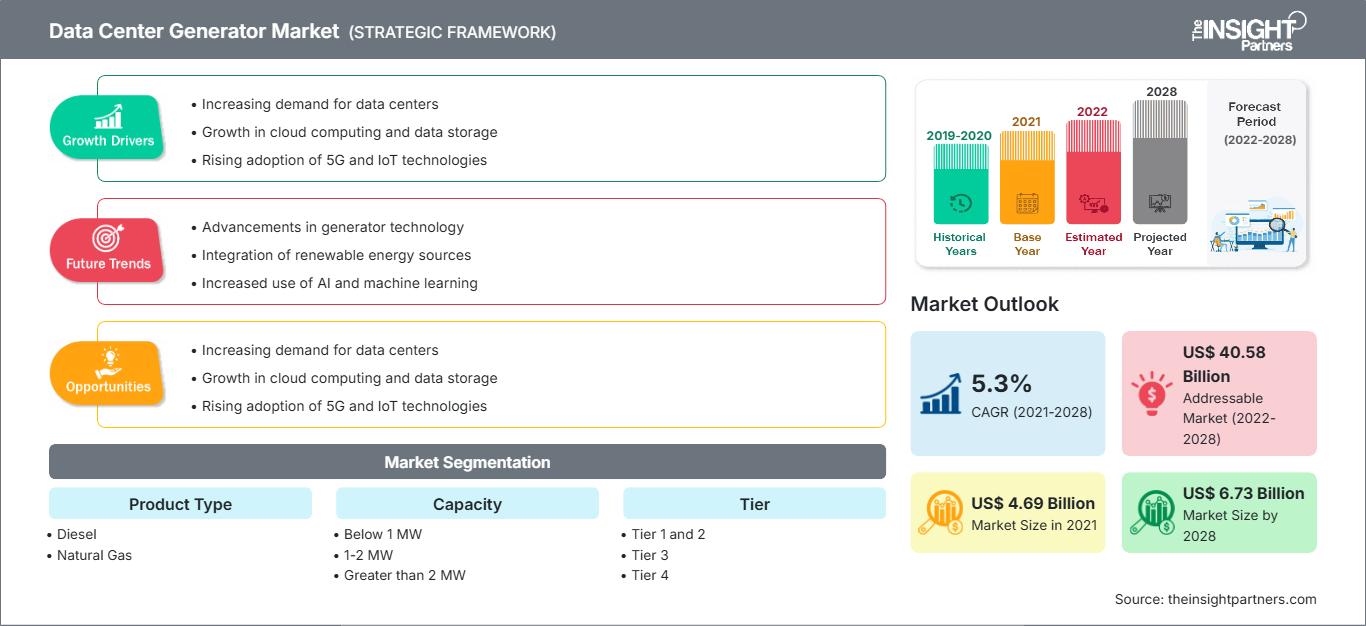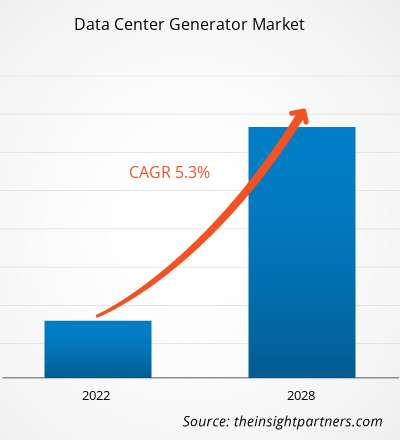[Forschungsbericht]Der Markt für Generatoren für Rechenzentren wurde im Jahr 2021 auf 4.693,00 Millionen US-Dollar geschätzt und soll bis 2028 6.729,53 Millionen US-Dollar erreichen; von 2021 bis 2028 wird eine durchschnittliche jährliche Wachstumsrate (CAGR) von 5,3 % erwartet.
Generatoren dienen Rechenzentren bei einem Stromausfall als Notstromversorgung. Ein vollständiger Stromausfall in einem Rechenzentrum kann einen Neustart des Systems erforderlich machen, was zu Systemausfällen, Startschwierigkeiten und Datenverlust führt. Daher verfügen Rechenzentren stets über eine Notstromversorgung durch Generatoren, um solche Anomalien und Ausfälle zu vermeiden. Diese Vorteile treiben das Wachstum des Marktes für Generatoren für Rechenzentren voran.
Diese Generatoren benötigen zum Betrieb keine vorhandene Stromversorgung, was ein wichtiger Treiber für den Markt ist. Darüber hinaus produzieren namhafte Hersteller Generatoren mit kundenspezifischer Kapazität, um auf die sich ändernde Kundennachfrage zu reagieren. Solche Systeme lassen sich je nach Strombedarf des Rechenzentrums skalieren. Diese Anpassungsfähigkeit dürfte die Nachfrage nach Generatoren für Rechenzentren erhöhen und damit das Marktwachstum ankurbeln. Mehrere Cloud-Service-Anbieter haben ihre Produktion aufgrund der weltweit steigenden Nachfrage nach Edge-Rechenzentren erhöht. Google beispielsweise investierte 2019 3,3 Milliarden US-Dollar in den Ausbau seiner Rechenzentrumspräsenz in Europa. Darüber hinaus dürfte der Markt von der zunehmenden Entwicklung von Hyperscale-Anlagen und der zunehmenden Implementierung von Diesel-Rotations-Unterbrechungsfreien Stromversorgungen (DRUPS) profitieren.
Passen Sie diesen Bericht Ihren Anforderungen an
Sie erhalten kostenlos Anpassungen an jedem Bericht, einschließlich Teilen dieses Berichts oder einer Analyse auf Länderebene, eines Excel-Datenpakets sowie tolle Angebote und Rabatte für Start-ups und Universitäten.
Markt für Rechenzentrumsgeneratoren: Strategische Einblicke

-
Holen Sie sich die wichtigsten Markttrends aus diesem Bericht.Dieses KOSTENLOSE Beispiel umfasst Datenanalysen, die von Markttrends bis hin zu Schätzungen und Prognosen reichen.
Markteinblicke für Rechenzentrumsgeneratoren
Zunahme der Anzahl von Rechenzentren
Im heutigen Datenzeitalter gibt es bereits rund sieben Milliarden mit dem Internet verbundene Geräte, und diese Zahl wächst weiter. Viele von ihnen produzieren riesige Datenmengen, die aufgezeichnet, weitergeleitet, gespeichert, ausgewertet und abgerufen werden müssen. Hersteller verlassen sich auf Big Data und Datenanalyse, um die Effizienz, Produktivität, Sicherheit und Kosteneffizienz ihrer Betriebsabläufe zu verbessern, während sich das Internet der Dinge (IoT) und Industrie 4.0 durchsetzen. Andererseits wird die interne Datenverwaltung zunehmend komplizierter, zeitaufwändiger und teurer. Um Energie- und Infrastrukturkosten zu sparen, erwägen selbst große Unternehmen wie Cisco, Teile ihrer internen Rechenzentren zu schließen.
Die zunehmende Verbreitung vernetzter Geräte und der einfache Internetzugang sowie die sinkenden Kosten für Internetdienste treiben die Nachfrage nach Datenspeicherung weltweit an. Der Bedarf an Datenspeicherung steigt ebenfalls sprunghaft an, da die Nachfrage nach Big Data-Analysen und Cloud-Diensten wie Online-Inhalten wie Filmen, Apps, Videos und sozialen Medien zunimmt. Daher stellen Cloud-basierte Unternehmen IT-Speicherplatz in ihren Rechenzentren bereit. Mehrere Branchen erkunden die Cloud-Angebote und entdecken die Vorteile von Rechenzentrumsdiensten zur Unterstützung ihrer Cloud-Anforderungen. Diese Entwicklungen wirken sich direkt auf die zunehmende Nutzung des Internets der Dinge (IoT) aus und führen wiederum zum Bau einer großen Zahl von Rechenzentren auf der ganzen Welt. Colt hat beispielsweise die Entwicklung seiner Hyperscale-Rechenzentren in Europa und im asiatisch-pazifischen Raum angekündigt, nachdem es 12 Edge-Colocation-Zentren in ganz Europa verkauft hatte. Das Unternehmen hat zehn neue Grundstücke in London, Frankfurt, Paris und an nicht genannten Standorten in Japan erworben, auf denen es rund 100 MW IT-Leistung erzeugen kann. Daher erhöht die steigende Zahl von Rechenzentren den Bedarf an Rechenzentrumsgeneratoren zur ausreichenden Stromversorgung, was das Wachstum des Marktes für Rechenzentrumsgeneratoren vorantreibt.
Markteinblicke nach Produkttypen
Die Nachfrage nach Rechenzentrumsgeneratoren ist in den letzten Jahren weltweit gestiegen. Die Unternehmen bieten drei Arten von Rechenzentrumsgeneratoren an: Diesel-, Erdgas- und Bi-Fuel-Generatoren. Im Januar 2022 gab Cummins Power Generation bekannt, dass es von der chinesischen Rechenzentrumsbranche für seine Stromversorgungslösungen ausgezeichnet wurde. Das Unternehmen stellt Dieselgeneratoren für Rechenzentren her. Im Januar 2021 gab TRG Datacenters die Modernisierung seines Rechenzentrums in Texas bekannt. Das Unternehmen plant die Installation einer Bi-Fuel-Option zur Notstromversorgung.
Markteinblicke nach Kapazität
In Bezug auf die Kapazität ist der Markt für Rechenzentrumsgeneratoren in unter 1 MW, 1–2 MW und über 2 MW unterteilt. Unter 1 MW ist die wichtigste Kapazität bei Generatoren für Rechenzentren. Anlagen mit einer Kapazität von über 10 MW setzen Generatoren mit über 2 MW ein. Generatoren mit einer Leistungskapazität von unter 1 MW werden üblicherweise in modularen Rechenzentren eingesetzt. Der Einsatz von Generatoren mit einer Leistungskapazität von unter 1 MW dürfte die Nutzung von Rechenzentren steigern. Sie werden von kleinen Rechenzentrumsbetreibern in Entwicklungsländern eingesetzt, da sie weniger kosten. Der Anstieg der Produktion von Hyperscale-Anlagen in Schwellenländern wird die Abhängigkeit von Generatoren mit geringer Kapazität in den kommenden Jahren verringern.
Die Akteure auf dem Markt für Generatoren für Rechenzentren verfolgen Strategien wie Fusionen, Übernahmen und Marktinitiativen, um ihre Position auf dem Markt zu behaupten. Im Folgenden sind einige Entwicklungen der wichtigsten Akteure auf dem Markt für Generatoren für Rechenzentren aufgeführt:
- ABB LTD hat eine neue Wellengeneratortechnologie eingeführt. Dieser neue Generator bietet Flexibilität und einfache Installation auf vielen Schiffen, darunter Massengutfrachtern und Containerschiffen. Der Permanentmagnet-Wellengenerator AMZ 1400 ist für die Umrichtersteuerung optimiert und bietet einen höheren Wirkungsgrad als Induktion.
- Caterpillar startet Demonstrationsprojekt mit Wasserstoff-Brennstoffzellentechnologie zur Notstromversorgung im Microsoft-Rechenzentrum. Dieses Projekt ermöglicht Caterpillar die Zusammenarbeit mit Branchenführern, um einen großen Schritt in Richtung kommerziell tragfähiger Energielösungen zu machen, die den Kunden gleichzeitig dabei helfen, ihren Betrieb nachhaltiger zu gestalten.
Markt für Rechenzentrumsgeneratoren
Die Analysten von The Insight Partners haben die regionalen Trends und Faktoren, die den Markt für Rechenzentrumsgeneratoren im Prognosezeitraum beeinflussen, ausführlich erläutert. In diesem Abschnitt werden auch die Marktsegmente und die geografische Lage in Nordamerika, Europa, dem asiatisch-pazifischen Raum, dem Nahen Osten und Afrika sowie Süd- und Mittelamerika erörtert.Umfang des Marktberichts zu Generatoren für Rechenzentren
| Berichtsattribut | Einzelheiten |
|---|---|
| Marktgröße in 2021 | US$ 4.69 Billion |
| Marktgröße nach 2028 | US$ 6.73 Billion |
| Globale CAGR (2021 - 2028) | 5.3% |
| Historische Daten | 2019-2020 |
| Prognosezeitraum | 2022-2028 |
| Abgedeckte Segmente |
By Produkttyp
|
| Abgedeckte Regionen und Länder |
Nordamerika
|
| Marktführer und wichtige Unternehmensprofile |
|
Dichte der Marktteilnehmer für Rechenzentrumsgeneratoren: Verständnis ihrer Auswirkungen auf die Geschäftsdynamik
Der Markt für Rechenzentrumsgeneratoren wächst rasant. Die steigende Nachfrage der Endnutzer ist auf Faktoren wie veränderte Verbraucherpräferenzen, technologische Fortschritte und ein stärkeres Bewusstsein für die Produktvorteile zurückzuführen. Mit der steigenden Nachfrage erweitern Unternehmen ihr Angebot, entwickeln Innovationen, um den Bedürfnissen der Verbraucher gerecht zu werden, und nutzen neue Trends, was das Marktwachstum weiter ankurbelt.
- Holen Sie sich die Markt für Rechenzentrumsgeneratoren Übersicht der wichtigsten Akteure
Der globale Markt für Generatoren für Rechenzentren ist nach Produkttyp, Kapazität und Stufe segmentiert. Basierend auf dem Produkttyp ist der Markt für Generatoren für Rechenzentren in Diesel, Erdgas und andere unterteilt. Hinsichtlich der Kapazität ist der Markt für Generatoren für Rechenzentren in weniger als 1 MW, 1–2 MW und mehr als 2 MW segmentiert. Darüber hinaus ist der Markt für Generatoren für Rechenzentren basierend auf der Stufe 1 & 2, Stufe 3 und Stufe 4 segmentiert.
ABB; Atlas Copco AB; Caterpillar; Cummins Inc.; DEUTZ AG; Generac Power Systems, Inc.; HITEC Power Protection; Kirloskar; Kohler Co.; und MITSUBISHI MOTORS CORPORATION sind die wichtigsten Akteure auf dem Markt für Generatoren für Rechenzentren, die für die Forschungsstudie berücksichtigt wurden. Darüber hinaus wurden in diesem Forschungsbericht mehrere andere bedeutende Akteure auf dem Markt für Generatoren für Rechenzentren untersucht und analysiert, um einen ganzheitlichen Überblick über die Größe des globalen Marktes für Generatoren für Rechenzentren und sein Ökosystem zu erhalten.
- Historische Analyse (2 Jahre), Basisjahr, Prognose (7 Jahre) mit CAGR
- PEST- und SWOT-Analyse
- Marktgröße Wert/Volumen – Global, Regional, Land
- Branchen- und Wettbewerbslandschaft
- Excel-Datensatz
Aktuelle Berichte
Verwandte Berichte
Erfahrungsberichte
Grund zum Kauf
- Fundierte Entscheidungsfindung
- Marktdynamik verstehen
- Wettbewerbsanalyse
- Kundeneinblicke
- Marktprognosen
- Risikominimierung
- Strategische Planung
- Investitionsbegründung
- Identifizierung neuer Märkte
- Verbesserung von Marketingstrategien
- Steigerung der Betriebseffizienz
- Anpassung an regulatorische Trends






















 Kostenlose Probe anfordern für - Markt für Rechenzentrumsgeneratoren
Kostenlose Probe anfordern für - Markt für Rechenzentrumsgeneratoren